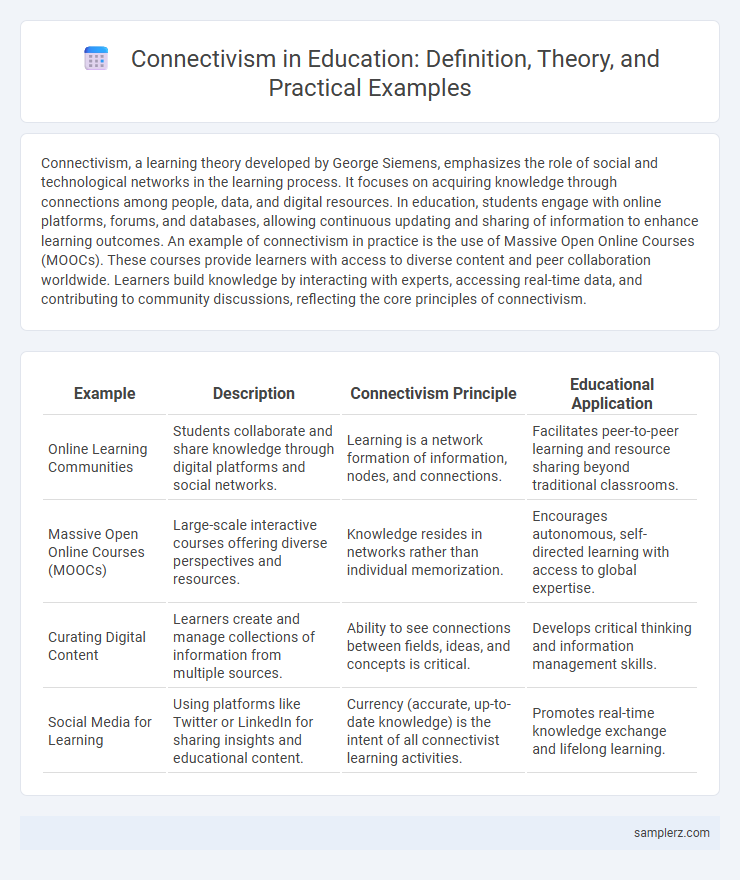Connectivism, a learning theory developed by George Siemens, emphasizes the role of social and technological networks in the learning process. It focuses on acquiring knowledge through connections among people, data, and digital resources. In education, students engage with online platforms, forums, and databases, allowing continuous updating and sharing of information to enhance learning outcomes. An example of connectivism in practice is the use of Massive Open Online Courses (MOOCs). These courses provide learners with access to diverse content and peer collaboration worldwide. Learners build knowledge by interacting with experts, accessing real-time data, and contributing to community discussions, reflecting the core principles of connectivism.
Table of Comparison
| Example | Description | Connectivism Principle | Educational Application |
|---|---|---|---|
| Online Learning Communities | Students collaborate and share knowledge through digital platforms and social networks. | Learning is a network formation of information, nodes, and connections. | Facilitates peer-to-peer learning and resource sharing beyond traditional classrooms. |
| Massive Open Online Courses (MOOCs) | Large-scale interactive courses offering diverse perspectives and resources. | Knowledge resides in networks rather than individual memorization. | Encourages autonomous, self-directed learning with access to global expertise. |
| Curating Digital Content | Learners create and manage collections of information from multiple sources. | Ability to see connections between fields, ideas, and concepts is critical. | Develops critical thinking and information management skills. |
| Social Media for Learning | Using platforms like Twitter or LinkedIn for sharing insights and educational content. | Currency (accurate, up-to-date knowledge) is the intent of all connectivist learning activities. | Promotes real-time knowledge exchange and lifelong learning. |
Understanding Connectivism: A Modern Learning Theory
Connectivism exemplifies modern education by emphasizing learning through networks and connections between people, information, and technology. Understanding connectivism involves recognizing the role of digital platforms in facilitating knowledge exchange and fostering collaborative problem-solving among learners. This theory highlights the dynamic nature of knowledge acquisition in the digital age, where learning is continuous and distributed across various sources.
Core Principles of Connectivism in Education
Connectivism emphasizes that learning occurs through networks where knowledge is distributed across connections between people, technology, and information sources. Core principles include the importance of nurturing diverse learning communities, recognizing the role of digital platforms in facilitating knowledge flow, and valuing the ability to identify and navigate relevant information nodes. This theory shifts focus from individual cognition to networked learning, highlighting adaptability and connected knowledge as essential educational competencies.
Digital Networks as Learning Environments
Digital networks as learning environments exemplify connectivism by enabling learners to access diverse knowledge sources through online platforms such as MOOCs, social media, and collaborative forums. These networks facilitate the formation of learning communities where individuals share information, solve problems collectively, and update their understanding dynamically. The continuous interaction within these digital ecosystems mirrors the connectivist principle that learning is distributed across a network of connections.
Examples of Connectivism in Online Classrooms
Connectivism in online classrooms is exemplified through interactive platforms like discussion forums and social media groups, where students collaboratively share resources and knowledge. Learning management systems (LMS) such as Moodle and Canvas facilitate networked learning by connecting learners with diverse content and peers globally. Real-time video conferencing tools, including Zoom and Microsoft Teams, enable synchronous communication that supports dynamic knowledge exchange and community building.
Collaboration and Knowledge Sharing in Virtual Spaces
Connectivism emphasizes collaboration and knowledge sharing in virtual spaces through platforms like online forums, social media groups, and collaborative tools such as Google Docs and Slack, enabling learners to co-create and exchange information dynamically. These virtual environments facilitate the formation of learning networks where participants access diverse resources and expertise beyond traditional classroom boundaries. The integration of real-time communication and asynchronous interactions promotes continuous knowledge flow, essential for adapting in rapidly evolving educational contexts.
The Role of Social Media in Connectivist Learning
Social media platforms like Twitter and LinkedIn facilitate connectivist learning by enabling learners to access diverse perspectives and real-time information exchange. These platforms support networking opportunities where knowledge is co-created through interactive discussions, fostering collaborative problem-solving. The role of social media in connectivism highlights the importance of digital literacy and maintaining active learner networks for continuous knowledge development.
Connectivism in Practice: Case Studies from Schools
Connectivism in practice is demonstrated by schools integrating digital platforms like Google Classroom and Edmodo to foster collaborative learning and knowledge sharing among students. Case studies reveal how virtual networks enable learners to access diverse resources and experts beyond traditional classrooms, enhancing critical thinking and problem-solving skills. These implementations highlight the shift towards learner-centered education, emphasizing connectivity, technology use, and real-time information exchange.
Real-World Applications of Connectivist Theory
Connectivism emphasizes learning through networks, demonstrated in online platforms where students collaborate globally to solve complex problems, reflecting real-world knowledge exchange. Tools like MOOCs and social media enable learners to access diverse information sources, enhancing critical thinking and adaptability. This approach mirrors professional environments where continuous learning and connectivity drive innovation and decision-making.
Technology-Enhanced Peer Learning Dynamics
Connectivism emphasizes the role of technology in facilitating peer learning by enabling students to connect through digital platforms such as social media, online forums, and collaborative tools like Google Docs. These technologies support dynamic knowledge exchange and collective problem-solving, allowing learners to access diverse perspectives and resources beyond traditional classroom boundaries. Platforms like MOOCs and virtual study groups exemplify how technology-enhanced peer learning fosters continuous skill development and networked learning environments.
Addressing Challenges in Connectivist Education
Connectivism addresses challenges in education by leveraging digital networks and technology to facilitate knowledge sharing and collaboration among learners. It emphasizes creating connections between diverse information sources, enabling students to adapt to rapidly changing information landscapes. Educators implement strategies such as interactive online platforms and social media integration to overcome issues of learner isolation and information overload.

example of connectivism in theory Infographic
 samplerz.com
samplerz.com